Submitted:
08 February 2024
Posted:
12 February 2024
You are already at the latest version
Abstract
Keywords:
1. Introduction
2. Study Area and Data Sources
2.1. Study Area
2.2. Data Sources
3. Methodology
3.1. Overall Framework
3.2. Index System for UFR
3.2.1. Primary Indicators
3.2.2. Secondary Indicators
3.3. Subjective and Objective Weight Calculation Method
3.4. TOPSIS Comprehensive Evaluation Method
3.5. Gray Relational Analysis
3.6. Resilience Level Assessment
3.6.1. UFR Level Classification
3.6.2. Establishment of Resilience Level Evaluation Model
4. Evaluation Index Set Analysis Results
4.1. Indicator Correlations
4.2. Temporal Evolution of UFR
4.2.1. Urban Flood Resilience
4.2.2. Socio-Economic Resilience
4.2.3. Ecological Resilience
4.2.4. Infrastructure Resilience
5. Evolution of UFR Level
6. Discussion and Conclusions
6.1. Improvement Strategy
6.2. Limitations
6.3. Conclusion
- (1)
- In accordance with previous research on resilience assessment methods and considering national regulations and expert recommendations, indicators that can represent a city's ability to resist floods were selected. A three-level indicator system was constructed, with the first-level indicator UFR, the second-level indicators being socio-economic resilience, ecological resilience, and infrastructure resilience, and a total of 17 third-level indicators. The gray relational degrees of all evaluation indicators were greater than 0.58, indicating that the selection of indicators was reasonable.
- (2)
- From 2010 to 2022, the UFR level of Yingtan City steadily increased, showing an overall improvement of 80.69%. In terms of subsystem dimensions, while ecological resilience exhibited a fluctuating downward trend, both socio-economic resilience and infrastructure resilience showed clear growth trends. The factors influencing Yingtan City's UFR are primarily concentrated in the density of the urban pipe network, per capita GDP, local fiscal expenditures, land development intensity, the number of medical institution beds per ten thousand people, the density of the urban road network, per capita refuge area, and emergency drainage capacity.
- (3)
- This study employed the natural breaks method, based on statistical data from all cities in China, to set the grade intervals of each indicator for the assessment years. Subsequently, the flood resilience grades for Yingtan City in the years 2010, 2016, and 2022 were calculated. The flood resilience grades were categorized as Level III in 2010 and 2016, and Level IV in 2022, indicating a continuous improvement in Yingtan City's flood resilience grades. The trend of flood resilience at a time scale was reviewed, and it can be concluded that the method used in this study is feasible.
Supplementary Materials
Author Contributions
Funding
Data Availability Statement
Acknowledgments
Conflicts of Interest
References
- Gao, Y.Q.; Chen, J.H.; Luo, H.; Wang, H.Z. Prediction of hydrological responses to land use change. SCIENCE OF THE TOTAL ENVIRONMENT 2020, 708. [Google Scholar] [CrossRef] [PubMed]
- Gu, L.; Chen, J.; Yin, J.B.; Slater, L.J.; Wang, H.M.; Guo, Q.; Feng, M.Y.; Qin, H.; Zhao, T.T.G. Global Increases in Compound Flood-Hot Extreme Hazards Under Climate Warming. GEOPHYSICAL RESEARCH LETTERS 2022, 49. [Google Scholar] [CrossRef]
- Zhu, S.; Li, D.; Huang, G.; Chhipi-Shrestha, G.; Nahiduzzaman, K.M.; Hewage, K.N.; Sadiq, R. Enhancing urban flood resilience: A holistic framework incorporating historic worst flood to Yangtze River Delta, China. International Journal of Disaster Risk Reduction 2021. [Google Scholar] [CrossRef]
- Wu, J.D.; Han, G.Y.; Zhou, H.J.; Li, N. Economic development and declining vulnerability to climate-related disasters in China. ENVIRONMENTAL RESEARCH LETTERS 2018, 13. [Google Scholar] [CrossRef]
- Zhang, X.X.; Sheng, W.F.; Qi, S.Z. Hazards and reflection on Fangshan District extreme rainstorm of July 21, 2012, the urban mountainous region of Beijing, North China. NATURAL HAZARDS 2018, 94, 1459–1461. [Google Scholar] [CrossRef]
- Liu, X.; Zhou, P.; Lin, Y.C.; Sun, S.W.; Zhang, H.L.; Xu, W.Q.; Yang, S.D. Influencing Factors and Risk Assessment of Precipitation-Induced Flooding in Zhengzhou, China, Based on Random Forest and XGBoost Algorithms. INTERNATIONAL JOURNAL OF ENVIRONMENTAL RESEARCH AND PUBLIC HEALTH 2022, 19. [Google Scholar] [CrossRef] [PubMed]
- Nahiduzzaman, K.M.; Aldosary, A.S.; Rahman, M.T. Flood induced vulnerability in strategic plan making process of Riyadh city. Habitat International 2015, 49, 375–385. [Google Scholar] [CrossRef]
- Cassel, M.A.; Hinsberger, M. Flood partnerships: a participatory approach to develop and implement the Flood Risk Management Plans. JOURNAL OF FLOOD RISK MANAGEMENT 2017, 10, 164–172. [Google Scholar] [CrossRef]
- McClymont, K.; Morrison, D.; Beevers, L.; Carmen, E. Flood resilience: a systematic review. Journal of Environmental Planning and Management 2019, 63, 1151–1176. [Google Scholar] [CrossRef]
- Holling, C.S. Resilience and Stability of Ecological Systems. Annual Review of Ecology and Systematics 1973, 4, 1–23. [Google Scholar] [CrossRef]
- Saikia, P.; Beane, G.; Garriga, R.G.; Avello, P.; Ellis, L.; Fisher, S.; Leten, J.; Ruiz-Apilánez, I.; Shouler, M.; Ward, R.; et al. City Water Resilience Framework: A governance based planning tool to enhance urban water resilience. Sustainable Cities and Society 2022, 77, 103497. [Google Scholar] [CrossRef]
- Zhang, Y.; Yue, W.C.; Su, M.R.; Teng, Y.M.; Huang, Q.Y.; Lu, W.W.; Rong, Q.Q.; Xu, C. Assessment of urban flood resilience based on a systematic framework. ECOLOGICAL INDICATORS 2023, 150. [Google Scholar] [CrossRef]
- Huang, G.; Li, D.; Zhu, X.; Zhu, J. Influencing factors and their influencing mechanisms on urban resilience in China. Sustainable Cities and Society 2021, 74, 103210. [Google Scholar] [CrossRef]
- Li, W.; Jiang, R.; Wu, H.; Xie, J.; Zhao, Y.; Song, Y.; Li, F. A System Dynamics Model of Urban Rainstorm and Flood Resilience to Achieve the Sustainable Development Goals. Sustainable Cities and Society 2023, 96, 104631. [Google Scholar] [CrossRef]
- Chen, N.C.; Yao, S.; Wang, C.; Du, W.Y. A Method for Urban Flood Risk Assessment and Zoning Considering Road Environments and Terrain. SUSTAINABILITY 2019, 11. [Google Scholar] [CrossRef]
- Zhong, M.; Lin, K.R.; Tang, G.P.; Zhang, Q.; Hong, Y.; Chen, X.H. A Framework to Evaluate Community Resilience to Urban Floods: A Case Study in Three Communities. SUSTAINABILITY 2020, 12. [Google Scholar] [CrossRef]
- Ghasemzadeh, B.; Zarabadi, Z.S.S.; Majedi, H.; Behzadfar, M.; Sharifi, A. A Framework for Urban Flood Resilience Assessment with Emphasis on Social, Economic and Institutional Dimensions: A Qualitative Study. SUSTAINABILITY 2021, 13. [Google Scholar] [CrossRef]
- Li, Z.; Zhang, X.; Ma, Y.; Feng, C.; Hajiyev, A. A multi-criteria decision making method for urban flood resilience evaluation with hybrid uncertainties. International Journal of Disaster Risk Reduction 2019, 36, 101140. [Google Scholar] [CrossRef]
- Zhang, Y.; Shang, K.J. Cloud model assessment of urban flood resilience based on PSR model and game theory. INTERNATIONAL JOURNAL OF DISASTER RISK REDUCTION 2023, 97. [Google Scholar] [CrossRef]
- Cao, F.F.; Xu, X.F.; Zhang, C.L.; Kong, W.B. Evaluation of urban flood resilience and its Space-Time Evolution: A case study of Zhejiang Province, China. ECOLOGICAL INDICATORS 2023, 154. [Google Scholar] [CrossRef]
- Ji, J.; Wang, D.Y. Evaluation analysis and strategy selection in urban flood resilience based on EWM-TOPSIS method and graph model. JOURNAL OF CLEANER PRODUCTION 2023, 425. [Google Scholar] [CrossRef]
- Moghadas, M.; Asadzadeh, A.; Vafeidis, A.; Fekete, A.; Kötter, T. A multi-criteria approach for assessing urban flood resilience in Tehran, Iran. INTERNATIONAL JOURNAL OF DISASTER RISK REDUCTION 2019, 35. [Google Scholar] [CrossRef]
- Datola, G. Implementing urban resilience in urban planning: A comprehensive framework for urban resilience evaluation. Sustainable Cities and Society 2023, 98, 104821. [Google Scholar] [CrossRef]
- Zhu, S.Y.; Li, D.Z.; Huang, G.Y.; Chhipi-Shrestha, G.; Nahiduzzaman, K.M.; Hewage, K.; Sadiq, R. Enhancing urban flood resilience: A holistic framework incorporating historic worst flood to Yangtze River Delta, China. INTERNATIONAL JOURNAL OF DISASTER RISK REDUCTION 2021, 61. [Google Scholar] [CrossRef]
- Galderisi, A. Urban resilience: A framework for empowering cities in face of heterogeneous risk factors. Z magazine (Boston, Mass.) 2014, 11, 36–58. [Google Scholar]
- Ji, J.; Chen, J.F. Urban flood resilience assessment using RAGA-PP and KL-TOPSIS model based on PSR framework: A case study of Jiangsu province, China. WATER SCIENCE AND TECHNOLOGY 2022, 86, 3264–3280. [Google Scholar] [CrossRef] [PubMed]
- Lianxiao; Morimoto, T.; Tong, S.Q.; An, C.; Bao, Y.H.; Fei, G. Evaluating Regional Flood Disaster Resilience Based on the DROP Model and TOPSIS Method: A Case Study of the Katsushika Ward, Tokyo. NATURAL HAZARDS REVIEW 2022, 23. [Google Scholar] [CrossRef]
- Leta, B.M.; Adugna, D. Characterizing the level of urban Flood vulnerability using the social-ecological-technological systems framework, the case of Adama city, Ethiopia. Heliyon 2023, 9, e20723. [Google Scholar] [CrossRef] [PubMed]
- Chang, H.; Pallathadka, A.; Sauer, J.; Grimm, N.B.; Zimmerman, R.; Cheng, C.; Iwaniec, D.M.; Kim, Y.; Lloyd, R.; McPhearson, T.; et al. Assessment of urban flood vulnerability using the social-ecological-technological systems framework in six US cities. Sustainable Cities and Society 2021, 68, 102786. [Google Scholar] [CrossRef]
- Aroca-Jiménez, E.; Bodoque, J.M.; García, J.A. An Integrated Multidimensional Resilience Index for urban areas prone to flash floods: Development and validation. Science of The Total Environment 2023, 894, 164935. [Google Scholar] [CrossRef]
- Zhao, L.; Zhang, T.; Fu, J.; Li, J.; Cao, Z.; Feng, P. Risk Assessment of Urban Floods Based on a SWMM-MIKE21-Coupled Model Using GF-2 Data. Remote Sensing 2021, 13. [Google Scholar] [CrossRef]
- Bonnefond, M. Hydraulic modeling as a condition of resilient urban projects in flood-prone area? HOUILLE BLANCHE-REVUE INTERNATIONALE DE L EAU, -33. [CrossRef]
- Li, F.; Wang, Q.; Hu, W.; Liu, J.; Zhang, X. Rapid assessment of disaster damage and economic resilience in relation to the flooding in Zhengzhou, China in 2021. Remote Sensing Letters 2022, 13, 651–662. [Google Scholar] [CrossRef]
- Rahman, M.; Ningsheng, C.; Mahmud, G.I.; Islam, M.M.; Pourghasemi, H.R.; Ahmad, H.; Habumugisha, J.M.; Washakh, R.M.A.; Alam, M.; Liu, E.; et al. Flooding and its relationship with land cover change, population growth, and road density. Geoscience Frontiers 2021, 12, 101224. [Google Scholar] [CrossRef]
- Oke, O.; Dougherty, E.; Rasmussen, K.L.; Morrison, R.R.; Carter, E. Spatial distribution of socio-demographic and housing-based factors in relation to flash and slow-rise flooding hazards in the U.S. ENVIRONMENTAL RESEARCH LETTERS 2023, 18. [Google Scholar] [CrossRef]
- Chen, X.S.; Jiang, S.L.; Xu, L.S.; Xu, H.G.; Guan, N.N. Resilience assessment and obstacle factor analysis of urban areas facing waterlogging disasters: a case study of Shanghai, China. ENVIRONMENTAL SCIENCE AND POLLUTION RESEARCH 2023, 30, 65455–65469. [Google Scholar] [CrossRef]
- Xu, C.; Rahman, M.; Haase, D.; Wu, Y.; Su, M.; Pauleit, S. Surface runoff in urban areas: The role of residential cover and urban growth form. Journal of Cleaner Production 2020, 262, 121421. [Google Scholar] [CrossRef]
- Li, C.; Liu, M.; Hu, Y.; Shi, T.; Qu, X.; Walter, M.T. Effects of urbanization on direct runoff characteristics in urban functional zones. Science of The Total Environment 2018, 643, 301–311. [Google Scholar] [CrossRef]
- Bu, J.H.; Peng, C.; Li, C.H.; Wang, X.; Zhang, Y.; Yang, Z.W.; Cai, Y.P. A method for determining reasonable water area ratio based on flood risk and cost-effectiveness in Rainy City. ENVIRONMENTAL EARTH SCIENCES 2020, 79. [Google Scholar] [CrossRef]
- Wang, S.; Jiang, R.; Yang, M.; Xie, J.; Wang, Y.; Li, W. Urban rainstorm and waterlogging scenario simulation based on SWMM under changing environment. Environmental Science and Pollution Research 2023, 30, 123351–123367. [Google Scholar] [CrossRef]
- Liu, Y.; Zhao, W.; Wei, Y.; Sebastian, F.S.M.; Wang, M. Urban waterlogging control: A novel method to urban drainage pipes reconstruction, systematic and automated. Journal of Cleaner Production 2023, 418, 137950. [Google Scholar] [CrossRef]
- Chen, P.; Zhang, J.; Jiang, X.; Liu, X.; Bao, Y.; Sun, Y. Scenario Simulation-Based Assessment of Trip Difficulty for Urban Residents under Rainstorm Waterlogging. International Journal of Environmental Research and Public Health 2012, 9, 2057–2074. [Google Scholar] [CrossRef] [PubMed]
- Ekaputra, R.A.; Lee, C.; Kee, S.-H.; Yee, J.-J. Emergency Shelter Geospatial Location Optimization for Flood Disaster Condition: A Review. Sustainability 2022, 14. [Google Scholar] [CrossRef]
- Sun, N.; Li, C.L.; Guo, B.Y.; Sun, X.K.; Yao, Y.K.; Wang, Y. Urban flooding risk assessment based on FAHP-EWM combination weighting: a case study of Beijing. GEOMATICS NATURAL HAZARDS & RISK 2023, 14. [Google Scholar] [CrossRef]
- Yoon, K. A Reconciliation Among Discrete Compromise Solutions. Journal of the Operational Research Society 1987, 38, 277–286. [Google Scholar] [CrossRef]
- Kuo, T. A review of some modified grey relational analysis models. Journal of Grey System 2017, 29, 70–77. [Google Scholar]
- Zhu, J.; Zhang, S.; Chen, Y.; Zhang, L. A Hierarchical Clustering Approach Based on Three-Dimensional Gray Relational Analysis for Clustering a Large Group of Decision Makers with Double Information. Group Decision and Negotiation 2015, 25, 325–354. [Google Scholar] [CrossRef]
- Cao, C.; Zhu, K.; Cai, F.; Qi, H.S.; Liu, J.H.; Lei, G.; Mao, Z.J.; Zhao, S.H.; Liu, G.; Su, Y. Vulnerability Evolution of Coastal Erosion in the Pearl River Estuary Great Bay Area Due to the Influence of Human Activities in the Past Forty Years. FRONTIERS IN MARINE SCIENCE 2022, 9. [Google Scholar] [CrossRef]
- Ruan, J.E.; Chen, Y.B.; Yang, Z.W. Assessment of temporal and spatial progress of urban resilience in Guangzhou under rainstorm scenarios. INTERNATIONAL JOURNAL OF DISASTER RISK REDUCTION 2021, 66. [Google Scholar] [CrossRef]
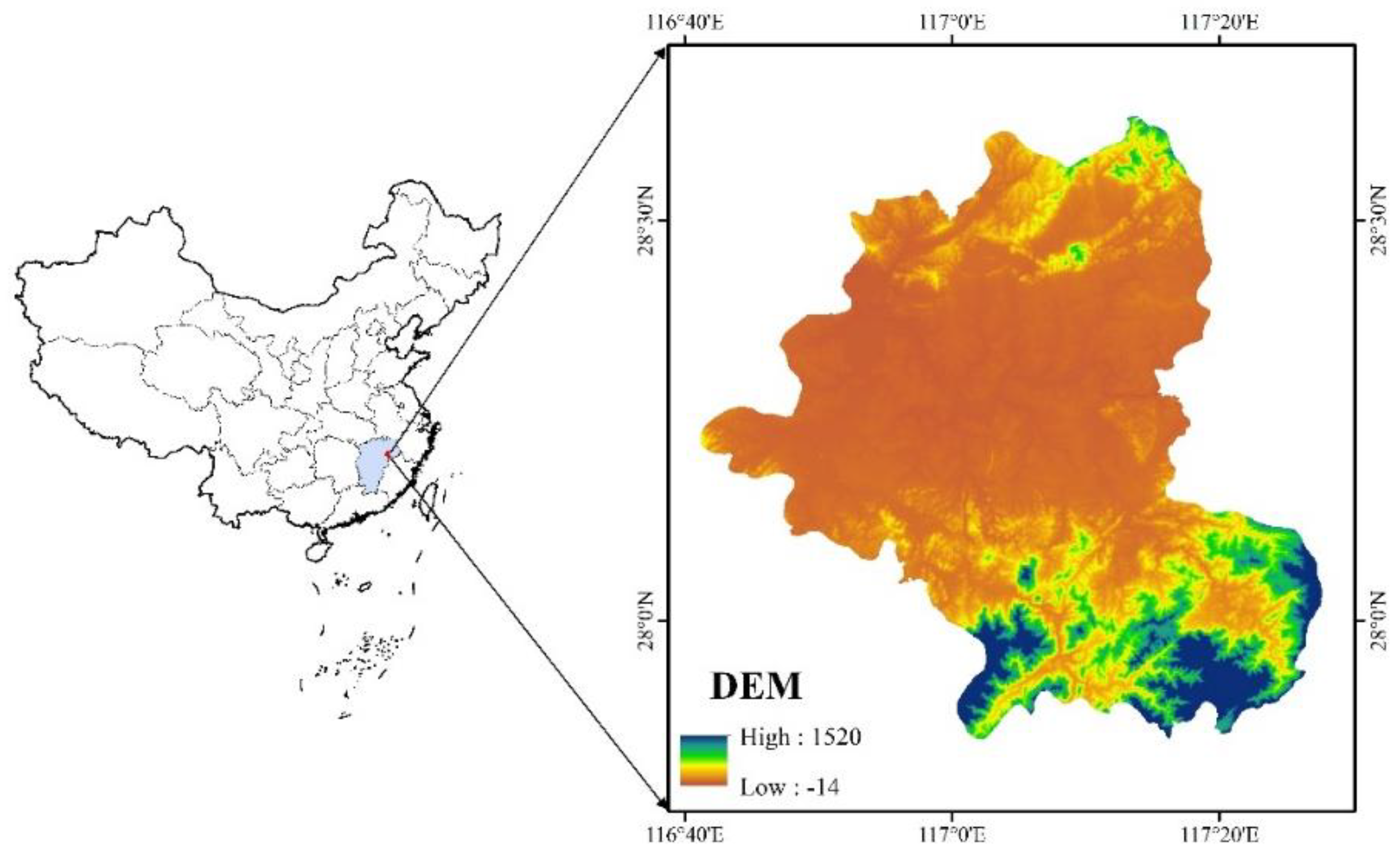
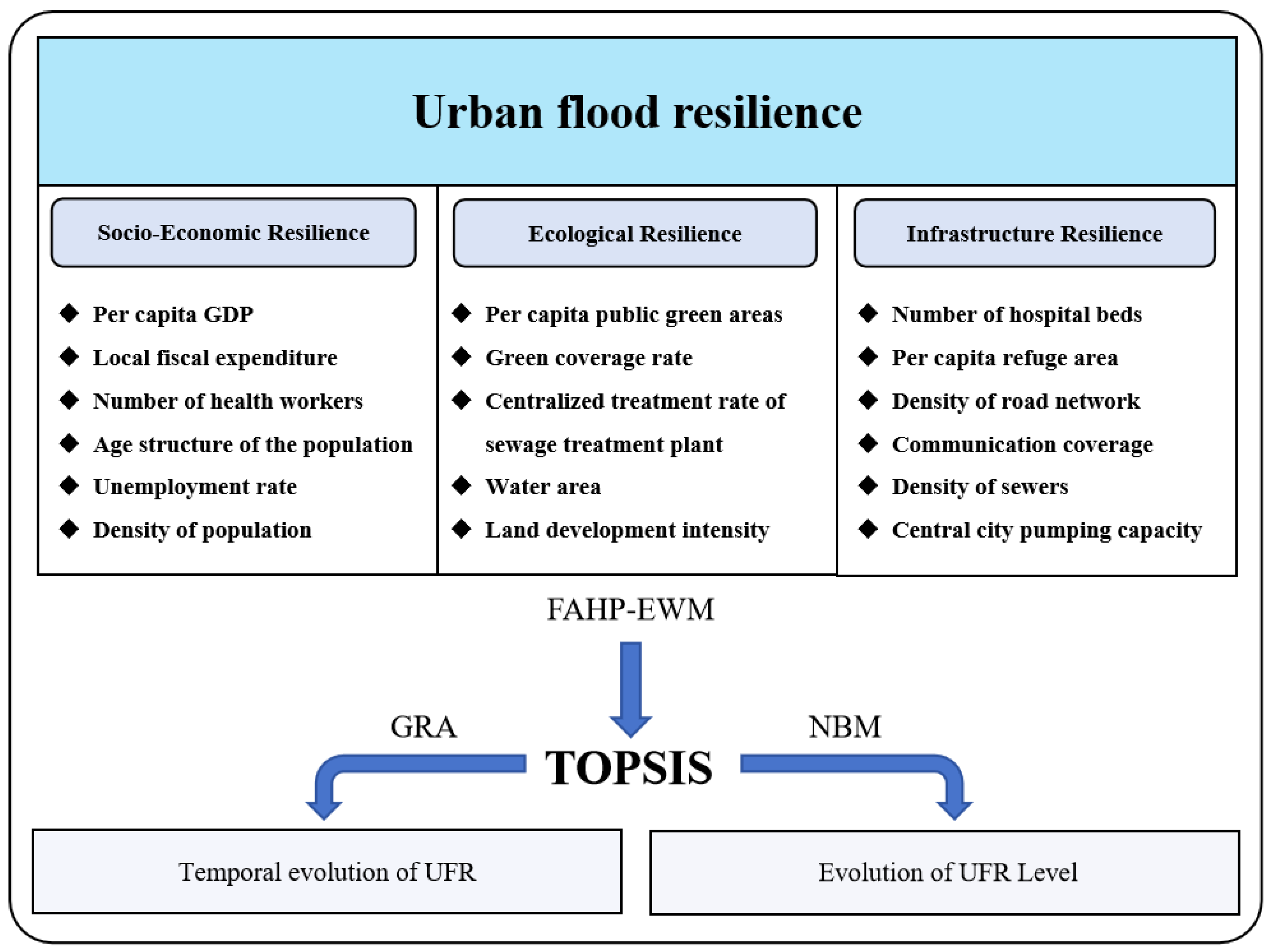
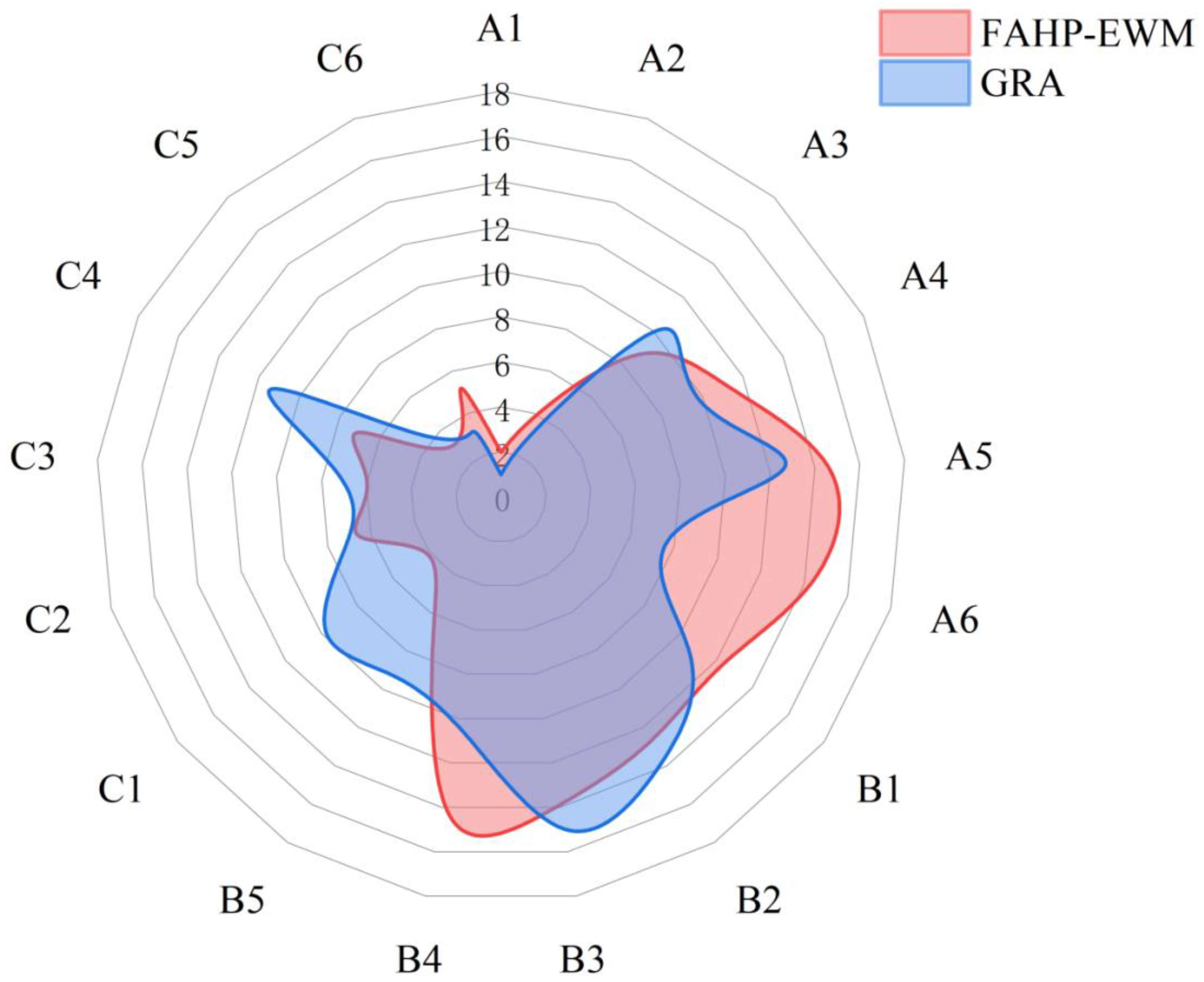
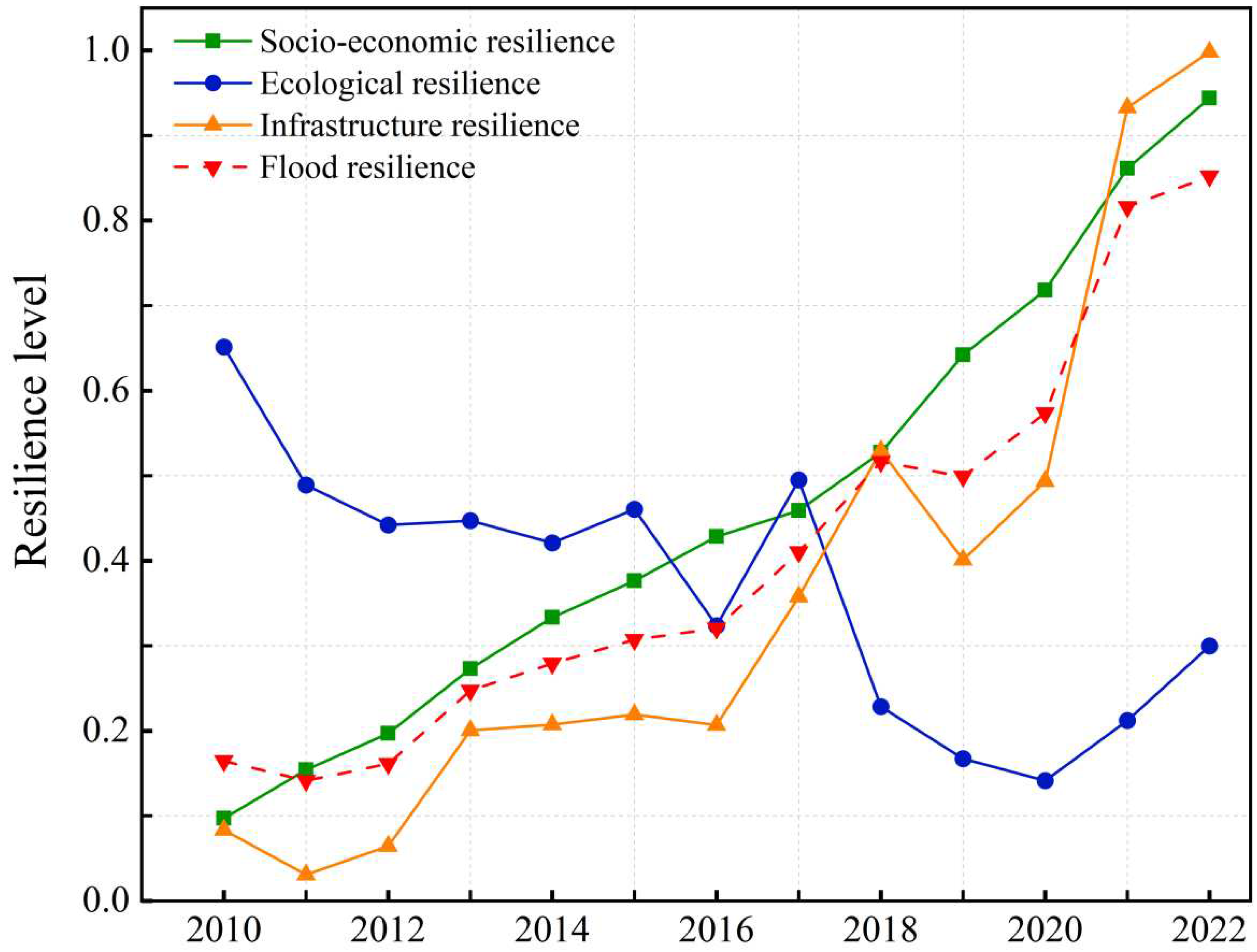
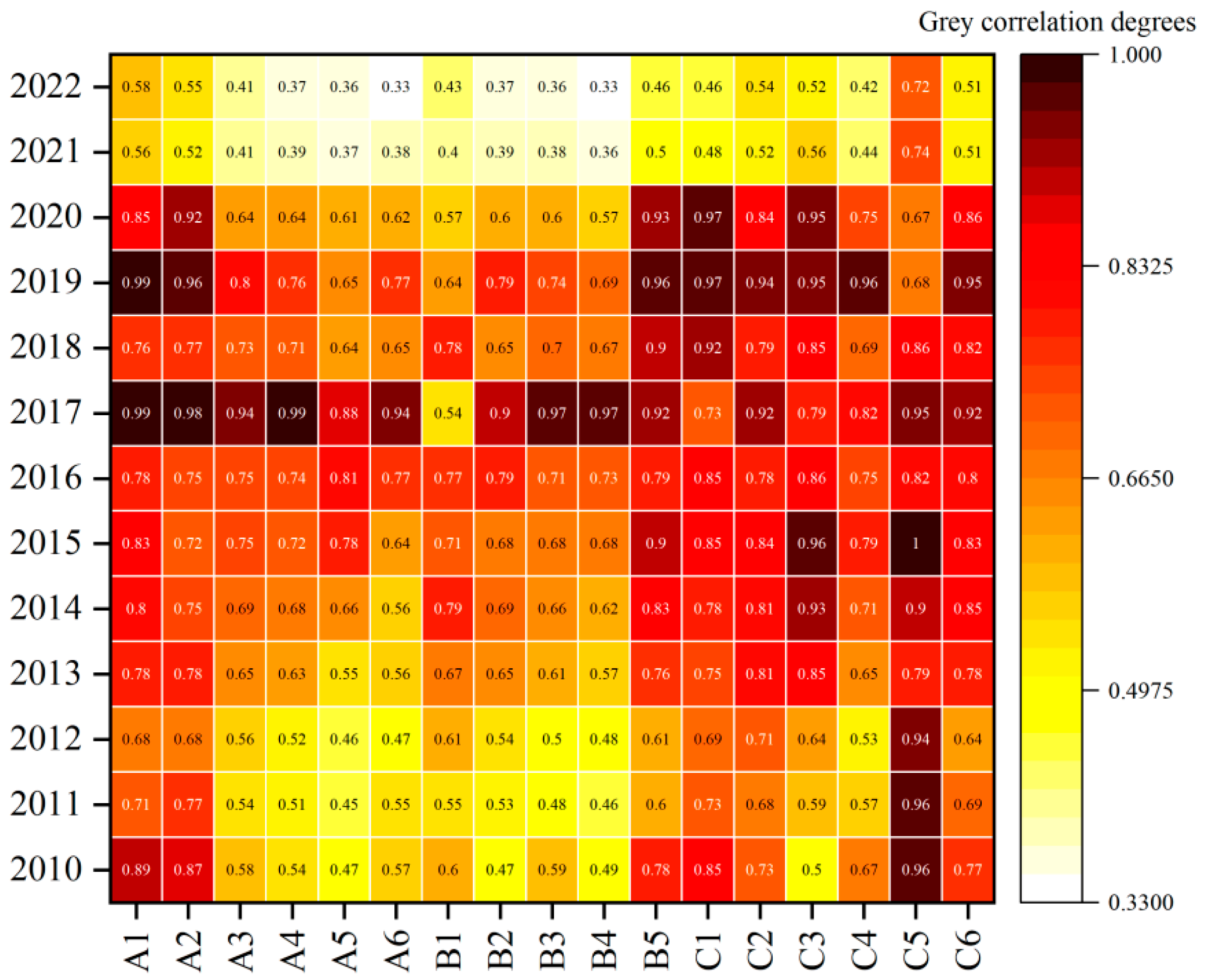
| Target Layer | Criterion Layer | Index Layer | Unit | Serial Number | Nature |
|---|---|---|---|---|---|
| Urban flood resilience | Socio-economic resilience (A) | Per capital GDP | RMB/person | A1 | + |
| Local fiscal expenditure | ten thousand RMB | A2 | + | ||
| Number of healthcare workers per 10 000 population | person | A3 | + | ||
| Percentage of population aged over 60 and under 18 | % | A4 | - | ||
| Unemployment rate | % | A5 | - | ||
| Density of population | persons/km2 | A6 | - | ||
| Ecological resilience (B) | Per capita public green areas | m2 | B1 | + | |
| Green coverage rate of built-up area | % | B2 | + | ||
| Centralized treatment rate of sewage treatment plant | % | B3 | + | ||
| Surface area of lakes and rivers | km2 | B4 | + | ||
| Land development intensity | % | B5 | - | ||
| Infrastructure resilience (C) | Number of hospital beds per 10 000 population | sheet | C1 | + | |
| Per capita refuge area | m2 | C2 | + | ||
| Density of road network in built district | km/km2 | C3 | + | ||
| Communication coverage | % | C4 | + | ||
| Density of sewers in built district | km/km2 | C5 | + | ||
| Central city pumping capacity | m3/s | C6 | + |
| Secondary Index | Unit | Level 1 | Level 2 | Level 3 | Level 4 | Level 5 |
|---|---|---|---|---|---|---|
| Per capita GDP (A1) | Yuan/person | 5304~19750 | 19750~33137 | 33137~52480 | 52480~83425 | 83425~175125 |
| Local fiscal expenditure (A2) | 100 million Yuan | 12.19~173.76 | 173.76~403.33 | 403.33~977.32 | 977.32~2061.51 | 2061.51~3302.89 |
| Number of healthcare workers per 10 000 population (A3) | person | 0~25 | 25~30 | 30~35 | 35~40 | >40 |
| Percentage of population aged over 60 and under 18 (A4) | % | >25 | 20~25 | 15~20 | 10~15 | 0~10 |
| Unemployment rate (A5) | % | 16.77~27.86 | 7.85~16.77 | 4.59~7.85 | 2.81~4.59 | 0~2.81 |
| Density of population (A6) | person/km2 | 8409~15217 | 5883~8409 | 3671~5883 | 1893~3671 | 137~1893 |
| Per capita public green areas (B1) | m2 | 0.43~7.11 | 7.11~11.21 | 11.21~15.50 | 15.50~23.30 | 23.30~41.92 |
| Green coverage rate of built-up area (B2) | % | 1.92~18.80 | 18.80~29.22 | 29.22~36.71 | 36.71~43.19 | 43.19~57.89 |
| Centralized treatment rate of sewage treatment plant (B3) | % | 0.27~28.84 | 28.84~52.28 | 52.28~71.34 | 71.34~86.35 | 86.35~100 |
| Surface area of lakes and rivers (B4) | km2 | 0~7 | 7~9 | 9~11 | 11~13 | >13 |
| Land development intensity (B5) | % | 15.75~41.67 | 7.23~15.75 | 2.82~7.23 | 1.05~2.82 | 0.02~1.05 |
| Number of hospital beds per 10 000 population (C1) | sheet | 12.72~24.14 | 24.14~32.91 | 32.91~45.51 | 45.51~64.67 | 64.67~110.85 |
| Per capita refuge area (C2) | m2 | 0~0.5 | 0.5~1.5 | 1.5~2.5 | 2.5~3.5 | >3.5 |
| Density of road network in built district (C3) | km/km2 | 1.26~4.99 | 4.99~7.09 | 7.09~9.80 | 9.80~14.38 | 14.38~23.60 |
| Communication coverage (C4) | % | 50~60 | 60~70 | 70~80 | 80~90 | 90~100 |
| Density of sewers in built district (C5) | km/km2 | 0~4.94 | 4.94~8.13 | 8.13~12.11 | 12.11~20.45 | 20.45~40.76 |
| Central city pumping capacity (C6) | m3/s | 0~2 | 2~10 | 10~50 | 50~200 | >200 |
| Index Level | A1 | A2 | A3 | A4 | A5 | A6 | B1 | B2 | B3 | B4 | B5 | C1 | C2 | C3 | C4 | C5 | C6 |
|---|---|---|---|---|---|---|---|---|---|---|---|---|---|---|---|---|---|
| I | 1 | 1 | 1 | 1 | 1 | 1 | 1 | 1 | 1 | 1 | 1 | 1 | 1 | 1 | 1 | 1 | 1 |
| II | 2 | 2 | 2 | 2 | 2 | 2 | 2 | 2 | 2 | 2 | 2 | 2 | 2 | 2 | 2 | 2 | 2 |
| III | 3 | 3 | 3 | 3 | 3 | 3 | 3 | 3 | 3 | 3 | 3 | 3 | 3 | 3 | 3 | 3 | 3 |
| IV | 4 | 4 | 4 | 4 | 4 | 4 | 4 | 4 | 4 | 4 | 4 | 4 | 4 | 4 | 4 | 4 | 4 |
| V | 5 | 5 | 5 | 5 | 5 | 5 | 5 | 5 | 5 | 5 | 5 | 5 | 5 | 5 | 5 | 5 | 5 |
| UFR Rating | Di- | Di+ | Ci |
|---|---|---|---|
| I | 0 | 0.1532 | 0 |
| II | 0.0383 | 0.1149 | 0.2500 |
| III | 0.0766 | 0.0766 | 0.500 |
| IV | 0.1149 | 0.0383 | 0.7500 |
| V | 0.1532 | 0 | 1 |
| UFR Rating | Ci |
|---|---|
| I | 0≤Ci<0.25 |
| II | 0.25≤Ci<0.5 |
| III | 0.5≤Ci<0.75 |
| IV | 0.75≤Ci<1 |
| V | Ci=1 |
| Index | Gray Correlation Degree of Rising Period(2010-2022) |
|---|---|
| Per capita GDP (A1) | 0.78 |
| Local fiscal expenditure (A2) | 0.77 |
| Number of healthcare workers per 10 000 population (A3) | 0.65 |
| Percentage of population aged over 60 and under 18 (A4) | 0.63 |
| Unemployment rate (A5) | 0.59 |
| Density of population (A6) | 0.60 |
| Index | Gray Correlation Degree of Rising Period(2010-2020) | Gray Correlation Degree of Declining Period(2020-2022) |
|---|---|---|
| Per capita public green areas (B1) | 0.69 | 0.60 |
| Green coverage rate of built-up area (B2) | 0.72 | 0.68 |
| Centralized treatment rate of sewage treatment plant (B3) | 0.72 | 0.73 |
| The surface area of lakes and rivers (B4) | 0.75 | 0.82 |
| Land development intensity (B5) | 0.61 | 0.52 |
| Index | Gray Correlation Degree of Slow-Rise Period(2010-2016) | Gray Correlation Degree of Choppy Period(2016-2020) | Gray Correlation Degree of Rapid- Rise Period(2020-2022) |
|---|---|---|---|
| Number of hospital beds per 10 000 population (C1) | 0.69 | 0.80 | 0.56 |
| Per capita refuge area (C2) | 0.68 | 0.82 | 0.58 |
| Density of road network in built district (C3) | 0.71 | 0.86 | 0.59 |
| Communication coverage (C4) | 0.62 | 0.77 | 0.51 |
| Density of sewers in built district (C5) | 0.81 | 0.88 | 0.70 |
| Central city pumping capacity (C6) | 0.68 | 0.83 | 0.58 |
| Object | A1 | A2 | A3 | A4 | A5 | A6 | B1 | B2 | B3 | B4 | B5 | C1 | C2 | C3 | C4 | C5 | C6 |
|---|---|---|---|---|---|---|---|---|---|---|---|---|---|---|---|---|---|
| U1 | 2 | 1 | 3 | 1 | 4 | 4 | 3 | 5 | 4 | 4 | 5 | 2 | 4 | 2 | 1 | 1 | 3 |
| U2 | 3 | 1 | 3 | 1 | 3 | 3 | 3 | 4 | 5 | 4 | 5 | 2 | 5 | 1 | 3 | 1 | 3 |
| U3 | 4 | 1 | 3 | 1 | 4 | 4 | 4 | 5 | 5 | 3 | 5 | 4 | 5 | 3 | 5 | 4 | 4 |
| Object | Di- | Di+ | Ci |
|---|---|---|---|
| U1 | 0.0582 | 0.1110 | 0.3439 |
| U2 | 0.0673 | 0.1022 | 0.3971 |
| U3 | 0.0960 | 0.0624 | 0.6061 |
Disclaimer/Publisher’s Note: The statements, opinions and data contained in all publications are solely those of the individual author(s) and contributor(s) and not of MDPI and/or the editor(s). MDPI and/or the editor(s) disclaim responsibility for any injury to people or property resulting from any ideas, methods, instructions or products referred to in the content. |
© 2024 by the authors. Licensee MDPI, Basel, Switzerland. This article is an open access article distributed under the terms and conditions of the Creative Commons Attribution (CC BY) license (https://creativecommons.org/licenses/by/4.0/).





